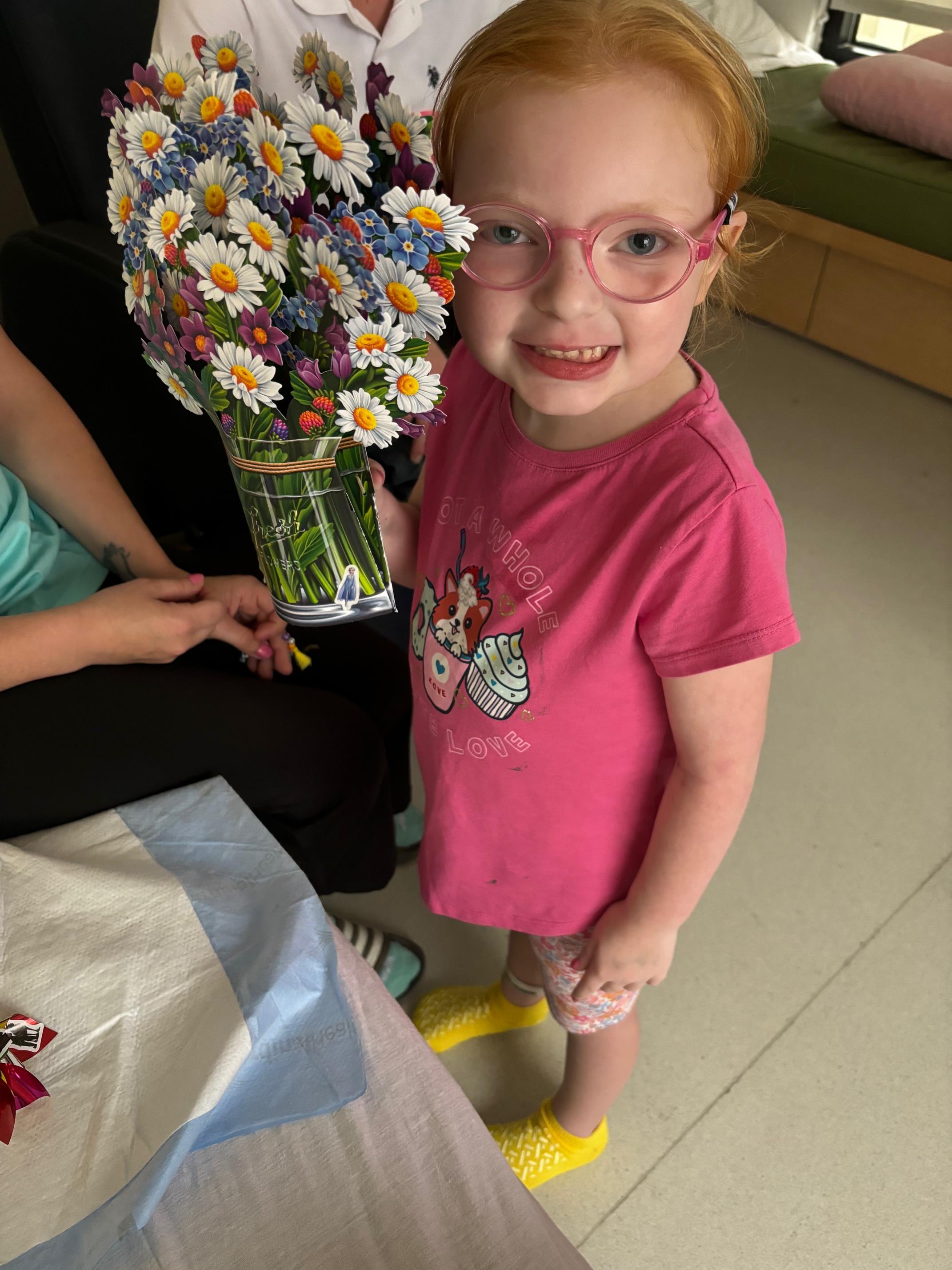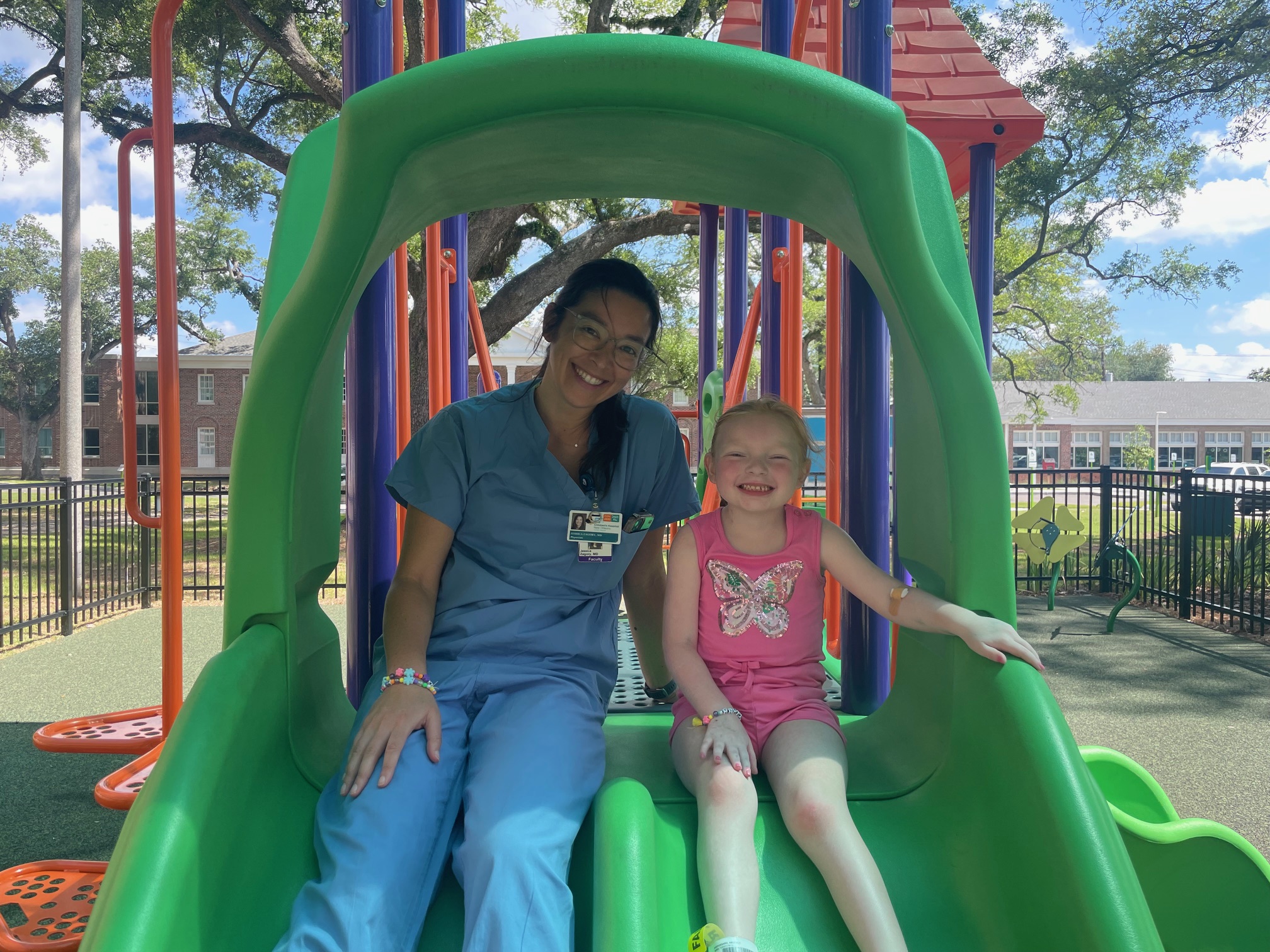Amberly's journey with Maple Syrup Urine Disease: From diagnosis to liver transplant
- Category: Patient Stories
- Posted on:

Meet Amberly, an energetic 6-year-old who has faced her share of challenges with remarkable strength and resilience. When she was born, her parents, David and Kaytlyn Broussard, were over the moon, filled with hopes and dreams for their precious little girl. But just days after her arrival at Women's Hospital in Baton Rouge, their world shifted in ways they could never have imagined.
“We got a call telling us to bring her to the hospital right away,” Kaytlyn recalls, still feeling the weight of that moment. “Amberly had already been cleared to leave the hospital before her newborn screening results came in. Later, we found out the screening showed elevated levels of amino acid in her blood.”
During her hospital visit in Baton Rouge, Amberly’s condition became critical when lab tests showed she had metabolic acidosis, caused by her body’s inability to break down certain amino acids. She was diagnosed with Maple Syrup Urine Disease (MSUD), a rare inherited disorder that prevents the body from processing amino acids properly. Without the necessary enzymes, these amino acids build up to toxic levels, posing serious health risks. The condition is named for the sweet, maple syrup-like odor of the urine. At just five days old, Amberly was flown to Children’s Hospital New Orleans for urgent care. 
In the Neonatal Intensive Care Unit (NICU), Amberly faced many challenges during her three-week stay. She received care and underwent treatments, including dialysis twice to address her metabolic acidosis.
“When the body is unable to break down certain amino acids in patients with maple syrup urine disease, these amino acids and their toxic byproducts can build up in the blood and lead to a metabolic crisis,” explained Patricio Arias, MD, Director of Pediatric Hepatology and Medical Director of Pediatric Liver Transplant at Children's Hospital, who was part of Amberly's medical care team. “This condition can affect the brain and can potentially cause an irreversible neurologic injury, which is why close monitoring and dietary management are crucial for individuals with maple syrup urine disease.”
Managing MSUD requires a strict low-protein diet to limit the amino acids the body can’t break down properly. In severe cases, some patients may even need to consider a liver transplant. Regular medical care, frequent blood tests, and monitoring the diet are all key to keeping the condition under control.
Amberly’s treatment began with a strict low-protein diet and a specialized medical formula to manage her condition. “She couldn’t have more than 6 grams of protein a day,” recalled Kaytlyn. “When she was a newborn, she had to get lab work every other week, and as she got older, it changed to once a month.”
As Amberly grew, her condition necessitated frequent hospital visits. She had regular visits with her geneticist, Jariya Upadia. MD and her pediatric hepatologist Patricio Arias, MD at Children’s Hospital.
Amberly's condition made even minor illnesses a serious concern. “Whenever she got sick, even with a cold, we had to take her to the ER because it could cause her body to go into acidosis,” Katelyn said.
Despite these challenges, Amberly’s spirit always shone through. "Most of our daughter’s childhood was spent in hospitals or at home," said her father, David. "Her immune system was fragile, so we chose to homeschool her to protect her from potential illnesses. We didn’t want to risk her getting sick at school."
In the face of these obstacles, the family remained hopeful. Discussions about a potential liver transplant began when Amberly was still little. Initially, the idea felt distant. However, when her care team at Children’s delved deeper into her case, it became apparent that a liver transplant might be necessary.
As Amberly continued to manage her condition with a strict low-protein diet, her hepatology team began to discuss long-term treatment options including a liver transplant.
“While maple syrup urine disease isn’t specifically an isolated liver condition, it is a genetic disorder that affects amino acid metabolism throughout the body,” explained Dr. Arias. “The liver plays a crucial role in this process, and a liver transplant is the only definitive cure. It provides a functioning copy of the enzyme needed to break down amino acids, correcting the metabolic imbalance caused by the deficiency.”
Amberly was on the liver transplant registry for a year before a match was found. 
“The day after Easter, we received the call from Dr. Arias saying we had a match,” the family shared, their voice filled with emotion. “We started crying. It was bittersweet. We were scared but also happy for her.”
Prior to her transplant, Amberly underwent a series of blood tests to confirm compatibility and ensure her body was ready for the procedure. These tests also checked her overall health and ruled out any infections or complications. Imaging scans, like CT scans and ultrasounds, were performed to assess the condition of her liver and surrounding organs, making sure the transplant could be safely carried out.
On April 7, 2024, Amberly received her liver transplant, performed by a team of surgeons, including Jessica Zagory, MD and Kiara Tulla, MD. A number of surgeons and members of the transplant team were present in the operating room to ensure everything went smoothly. The surgery lasted over 9 hours.
Amberly’s surgical course was special and required vigilance and constant monitoring. “There were a few challenges when it came time to close her up after the liver transplant,” said Kaytlyn. “Between blood clots and the liver not fitting properly (due to swelling after such a long operation), it was quite a process.” The surgical team ensured that her fluid status was optimized to ensure the liver was placed in perfect position and that closing the abdomen would be safe.
Emerging from sedation, Amberly was groggy but she soon began to show glimpses of her spirited personality. “After a couple of days, she started getting her little spunk back. She’d stick her tongue out at us or give us a thumbs up. It was good to see that little light didn’t diminish,” Kaytlyn said, reflecting on those challenging days.
Amberly also required stents in her bile ducts after the transplant to help with proper drainage which was performed by Russell Zwiener, MD, a pediatric advanced endoscopist at Children’s Hospital.
The support from the medical staff was invaluable. “I couldn’t thank them enough. The doctors and nurses were amazing, supportive, and always available to answer our questions. They even gave me their personal numbers,” Kaytlyn noted, grateful for the bonds formed during this trying time. Dr. Zagory would take her to the small park at the hospital, while Dr. Tulla would braid her hair, make bracelets with her, and talk. Child Life was amazing too! They provided her with activities including toys and games.”
Amberly spent 56 days in the hospital before she was ready to head back home to Baton Rouge. 
Today, Amberly is thriving post-transplant. She follows a strict regimen of anti-rejection medications and has bloodwork done every two weeks near their home in Baton Rouge. For follow-up visits, she sees Dr. Arias at the Gastroenterology, Hepatology, and Nutrition Clinic at Children’s Hospital.
At 6 years old, Amberly is loving life. She enjoys eating everything now, attends public school, and has made many friends. "She’s cute, but sometimes that girl has a switch," Kaytlyn joked. "She’s got red hair, and I always say that was God’s way of giving us a warning sign!" Amberly has many hobbies—she loves to sing, dance, and has been fascinated with gymnastics ever since watching the Olympics.
Despite the challenges they’ve faced, Kaytlyn and David remain optimistic about Amberly’s future. "She’s a warrior, and we’re so proud of her," David said. "Her journey has been tough, but it’s shown us the strength of our family and the importance of support."
“No matter how dark it may seem, there is always light,” said the Broussard family, offering advice to other families in similar situations. “Be patient. These kids are incredibly resilient. They are fighters.”
For more information about our hepatology program at Children’s Hospital, visit: Gastroenterology, Hepatology & Nutrition | Children's Hospital New Orleans (chnola.org)
For more information about the neonatal intensive care unit at Children’s Hospital, visit:
Neonatal Intensive Care | Children's Hospital New Orleans (chnola.org)



